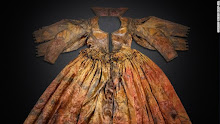I thought you’d enjoy my article, “A Veil of Distinction,” just published in the spring issue of Season Magazine. Click here to read it online...and I’ve reprinted it below as well.
A Veil of Distinction
Lace was immensely fashionable for Victorian and Edwardian
ladies and, indeed, de rigueur for
brides during these gilded decades. Following the creation of “rose point” lace
in Brussels in the mid-19th century—a type of point de gaze needle lace so named because of its lyrical rose
design, often with raised petals—this romantic pattern became a favorite of
brides. Therefore when well-to-do American women made their grand transatlantic
voyages to Europe on the most majestic luxury liner of the day (it was simply
the thing to do!), high on their must-do list was to bring back a lace veil from
Belgium—all with dreams of a wedding in mind. (Is that how the lovely rose point
veil worn by the Lee family brides—and then the Cecils of North Carolina—began
its notable pedigree?)
A Veil of Distinction
Wedding veils hold an especially distinctive yet intimate
place in a family’s collective memory. Even more than the wedding gown, the
family bridal veil has, historically, been the treasure most often passed down and
shared with daughters and granddaughters, nieces and cousins.
That was the case with a certain heirloom veil with a
most captivating provenance. First worn by Margaret Merritt as an Edwardian
bride when she married James Thomas Lee of New York City in 1903, her cathedral-length,
rose point lace veil was also worn by her daughters Marion Lee Ryan, Janet Lee
Bouvier and Winifred Lee D’Olier. But this veil developed a particular mystique
when her granddaughter Jacqueline Bouvier wore it, along with Margaret’s delicate
wreath of wax orange blossoms, for her
marriage to Senator John F. Kennedy in 1953.
I became intrigued by this veil’s lineage when I learned it
was to go on a first-ever display early this year as part of the wedding
costume exhibitions on Biltmore Estate in Asheville, North Carolina. The veil’s
connection with the Vanderbilt family is through Jackie Kennedy’s cousin, Mary
Lee Ryan—“Mimi” wore it when she married George Vanderbilt’s grandson, William
Amherst Cecil, in 1957.
Jackie’s only daughter Caroline Kennedy didn’t wear the Lee
family veil, but both Mimi’s daughter and daughter-in-law wore it with their
1980’s Diana-era “princess gowns.” I find this is part of the beauty and
pleasure of a bridal veil: as fashions change, it can be adapted to wear in various
stylish ways; and even as women and their roles change, because of its strong
feminine impulse, the bridal veil always carries a precious tradition.
Later when lace was not as popular and travel to Europe
was aboard airplanes instead of ships, bringing home a lace wedding veil stayed
dear to the hearts of many American women. Perhaps there is one stored away in your family’s “treasure chest”? ~





















No comments:
Post a Comment